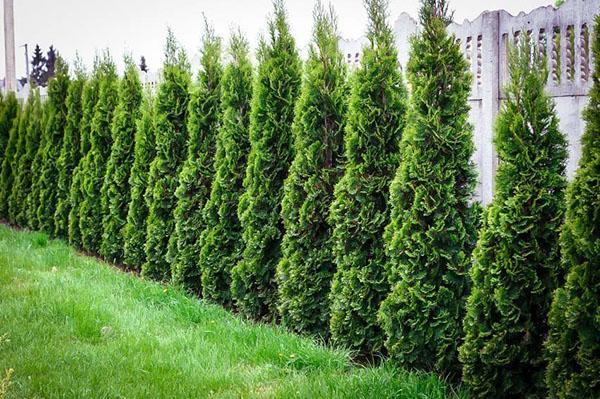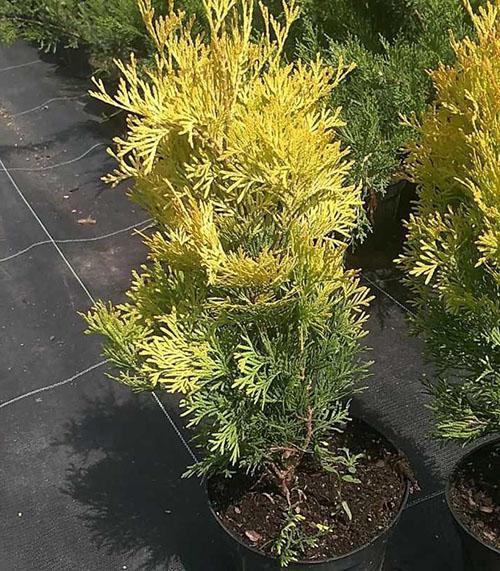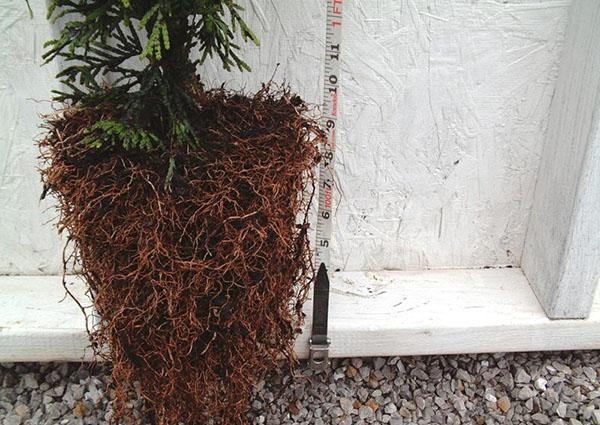Planting thuja in open ground and plant care rules
 Evergreen conifers are very popular due to their high decorativeness and undemandingness. Among such plants are thuja, planting and care in the open field for which even beginners can do it. In nature, thuja, the closest relatives to junipers and cypresses, are in the form of shrubs or tall trees with a dense crown and soft scaly needles.
Evergreen conifers are very popular due to their high decorativeness and undemandingness. Among such plants are thuja, planting and care in the open field for which even beginners can do it. In nature, thuja, the closest relatives to junipers and cypresses, are in the form of shrubs or tall trees with a dense crown and soft scaly needles.
Cultural varieties of plants are more compact than wild ones, they can have a golden or silvery-gray crown, while thuja are not capricious, they are not afraid of polluted air and they winter well in Russia.
When and how to plant an evergreen shrub? How to care for thuja in the country, and how does caring for a plant differ in different regions?
Thuja with an open root system can be planted in the ground in spring or autumn. The first option is preferable because the plant has time to acclimatize and root. In the fall, if you delay planting, there is a high risk of freezing of the bush.

How to plant thuja in the spring?
 Decorative thujas love light, but constant exposure to the sun is depressing. Such a shrub turns yellow, dries up and hibernates poorly. To prevent this from happening, a bright place is chosen for the thuja, protected from the midday sun and draft.
Decorative thujas love light, but constant exposure to the sun is depressing. Such a shrub turns yellow, dries up and hibernates poorly. To prevent this from happening, a bright place is chosen for the thuja, protected from the midday sun and draft.
Thuja, unpretentious and easily growing on soils of different composition, love moisture more than other conifers, but at the same time they are afraid of stagnant water, therefore, before planting thuja in spring, they properly prepare a hole, a loose aerated substrate, and also prepare a seedling.
Thuja soil is mixed on the basis of:
- 2 pieces of litter from coniferous forest or peat;
- 3 parts of sod land;
- 2 parts of humus;
- 1 part sand.
Mix into the substrate mineral fertilizers for conifers, according to the manufacturer's recommendations. If the soil in the country is sandy, no additional sand is added.
 Plants with an open root system often dry out on the way to their permanent residence. To replenish strength and revive the thuja will help immersion of the roots in settled water at room temperature, to which it is useful to add a root formation stimulator.
Plants with an open root system often dry out on the way to their permanent residence. To replenish strength and revive the thuja will help immersion of the roots in settled water at room temperature, to which it is useful to add a root formation stimulator.
Plants with a closed root system, especially from foreign nurseries, can be infected with harmful fungi, scale insects, spider mites, rust pathogens and other diseases.
So that when planting thuja in Siberia, as in the photo, care does not begin with the struggle for the life of a shrub, the plant must be examined in advance and treated from roots to crown with systemic insecticides and fungicides.
Thuja planting technology in spring: a step-by-step description
 The dimensions of the planting pit depend on the dimensions of the earthen coma and the root system of the seedling. For a thuja seedling at 3-4 years of age, a pit 50 to 100 cm wide and 60-70 cm deep is required.
The dimensions of the planting pit depend on the dimensions of the earthen coma and the root system of the seedling. For a thuja seedling at 3-4 years of age, a pit 50 to 100 cm wide and 60-70 cm deep is required.
A planting hole is made at a distance of 1-3 meters from other horticultural crops. The distance depends on the selected variety. The higher the shrub, the more space and nutrition is required for its superficial root system.
How to proceed further? Summer residents who do not have experience in growing conifers will need a step-by-step description of the technology for planting thuja in the spring.
- If the site is dense, heavy soil, drainage of sand, brick chips or expanded clay with a layer of 15 to 20 cm must be done at the bottom.
- Then part of the prepared soil is poured onto the bottom with a cone for a seedling with an open root system and an even layer for a plant in a container.
- A bush with a closed root system is removed from the container and placed in the center of the pit. The roots of the shrub without a container are straightened and evenly spread over an earthen cone.
- It is important that the root collar of the thuja is not below the soil level.
- When the pit is covered with soil, it is slightly compacted.
- The soil under the planted thuja is watered abundantly so that the soil is moist to the entire depth of the pit. This requires 10 to 20 liters.
- In conclusion, the trunk circle mulch chopped grass or peat.
 A loose protective layer of mulch will allow you to save moisture, protect the root system from decay when planting thuja and care in the Leningrad region, as well as from freezing during return cold in Siberia or the Urals.
A loose protective layer of mulch will allow you to save moisture, protect the root system from decay when planting thuja and care in the Leningrad region, as well as from freezing during return cold in Siberia or the Urals.
Thuja care after planting in the open field

Tui respond well to water. With its lack, the shrub loses its brightness and tone, the needles gradually turn yellow, and the crown thins.
Focusing on the weather, the humidity of the air and soil, the plants in the garden are regularly watered. In dry weather, this should be done every 3-4 days. Irrigating the crown in the morning or evening will help:
- keep the greenery alive and beautiful;
- activate the breathing of the shoots.
Caring for thuja in the open field after planting involves the removal of weeds and careful loosening of the soil under the bushes. Since the roots of the thuja are superficial, you should not disturb the soil deeper than 8–10 cm. Laying peat or sawdust mulch will help to simplify the task, the layer of which is renewed as needed.
Feeding thuja in spring gives the plant strength for quick recovery after wintering and activates the growth of young shoots. As a fertilizer, complex formulations for coniferous crops with a predominance of nitrogen... Liquid top dressing is applied in the morning or evening hours on wet soil.
 If fertilizers were added when planting in the ground, the first feeding of the thuja is carried out only two years after planting, when the soil has completely thawed. This is especially important when planting and caring for thuja in the Urals, Siberia and other regions with a harsh climate.
If fertilizers were added when planting in the ground, the first feeding of the thuja is carried out only two years after planting, when the soil has completely thawed. This is especially important when planting and caring for thuja in the Urals, Siberia and other regions with a harsh climate.
Roots in warm soil will immediately assimilate nutrients and stimulate the growth of shoots. If fertilizers get into frozen soil, they can cause rotting of the root system.
Thuja pruning in spring
 Evergreen shrubs practically do not change over the winter. In the cold season, some of the thuja varieties acquire a brown hue, their development is inhibited and resumed only with the arrival of heat.
Evergreen shrubs practically do not change over the winter. In the cold season, some of the thuja varieties acquire a brown hue, their development is inhibited and resumed only with the arrival of heat.
Caring for thujas in the spring necessarily includes sanitary pruning, which allows the crown to be freed from dry and severely damaged branches. Until the shoots have begun to grow, they carry out the spring formation of the crown. This must be done carefully, cutting off no more than a third of the length of the shoot. In the future, pruning helps to maintain the shape of the shrub, and also stimulates branching, making the plant denser, lively, green.
Hot summers can lead to the loss or weakening of some branches. In this case, don't wait for autumn. Sanitary pruning of thuja is carried out as needed. If the shoot is not dead, but only weakened, a haircut can push its recovery.
The time for re-forming the bush in the middle lane begins in August and lasts until the end of September. In Siberia, the Urals and regions where the first frosts come earlier, the haircut will have to be done earlier.
By autumn, the growth of thuja freezes, the plant prepares for winter. If the soil is dry, the plants are watered abundantly in October before the snow falls.
Preparing for cold weather and caring for thuja after winter
 Most thuja species tolerate frosts without loss, however, young shrubs are best protected from low temperatures using spruce branches or other suitable materials. In the future, the growing shrub may not suffer from the cold, but from the breaks of the crown and burns of the needles that occur in February or March, when the snow melts and can no longer protect the branches.
Most thuja species tolerate frosts without loss, however, young shrubs are best protected from low temperatures using spruce branches or other suitable materials. In the future, the growing shrub may not suffer from the cold, but from the breaks of the crown and burns of the needles that occur in February or March, when the snow melts and can no longer protect the branches.
In Siberia, conifers lose their decorative effect both from an early spring burn and from drying out, as a result of soil freezing. These dangers often pursue large tall forms. Dwarf trees and squat plants tolerate even the most severe winters better, but they can warm up in spring with a dense crown and prolonged thawing of the soil.
Before winter, when caring for thuja:
- carry out sanitary pruning of the crown;
- shrubs water and huddle high;
- near-trunk circles are mulched abundantly with a layer of up to 15 cm.
 For the prevention of snow breaks, pyramidal and spherical shrubs are tied, securing the shape with twine, but without tightening, so as to prevent the appearance of delusion.
For the prevention of snow breaks, pyramidal and spherical shrubs are tied, securing the shape with twine, but without tightening, so as to prevent the appearance of delusion.
Covers for evergreen wintering plants have proven themselves quite well. Snow helps to preserve the decorative effect of thuja; both tall and low plants are abundantly sprinkled with it.
Before caring for thuja in the country, you need to know the features of the various forms of this culture.
Garden thuja are divided into vigorous, medium-sized specimens and ground cover forms. Among tall plants, it winters best of all, retains a bright color of needles and a thuja Braband up to 20 meters high is formed. Shrubs with a narrower pyramidal shape can fade, but columnar plants, even in Siberian conditions, retain their decorative effect well. Thuja Smaragd height of about 2 meters with an average growth rate both in winter and in summer it pleases with bright green needles, but without sufficient care it burns out.
 The most unpretentious and easy to care for are small plants that can be easily covered under snow and covered in spring to protect them from burns. They are good for planting and nursing in the Urals, Siberia and the Leningrad Region, where it is not always possible to grow large shrubs.
The most unpretentious and easy to care for are small plants that can be easily covered under snow and covered in spring to protect them from burns. They are good for planting and nursing in the Urals, Siberia and the Leningrad Region, where it is not always possible to grow large shrubs.
Thuja care after winter begins in February. The bright sun not only awakens everything to life, but also turns the snow into a hard crust, spoiling the bark, and burns the scaly needles. Therefore, before removing the shelter from the thuja after winter, they destroy the ice crust, and also carry out a number of measures to accelerate the thawing of the soil:
- the old mulch is removed;
- the bush is watered with hot water;
- the trunk circle is covered with a film or black non-woven material.
The bright spring sun is detrimental to the needles, which turn yellow and often fall off. From March to May, especially if the thuja grows in an open, sunny place, the shrub is covered with breathable material.
When the needles on the shoots are nevertheless damaged and lost their former splendor, the heavily dried, yellowed parts of the branches are cut off, and the crown is treated daily, irrigated with a solution of a growth stimulator.
Ice crust can damage the bark. After they removed the shelter for the winter, the thuja are examined, and the revealed lesions are covered with garden varnish.
Problems when caring for thuja outdoors
 Problems in growing thuja are most often associated with:
Problems in growing thuja are most often associated with:
- with a lack of attention;
- with the wrong planting or choosing a place for the bush;
- weakening of the wintering field;
- attack by pests or pathogens.
Tui are affected by pathogens of fungal and bacterial infections, manifested in the form of wilting of needles, the appearance of yellowness or brown spots on it. Without due attention and complex fungicide treatment the disease grows and can cause the death of the garden thuja. After the primary irrigation, the procedure is repeated after 2 weeks.
Among the pests dangerous for thuja:
- shields and false shields;
- spider mites;
- thuja moth;
- aphid;
- leaf rollers;
- bark beetles damaging the bark.
As a preventive measure, the plants are sprayed with an insecticide solution in early spring, repeating the treatment after 14 days.
If the thuja is planted correctly, and caring for the plant fully covers its needs, the shrub grows well and decorates the summer cottage for a long time.
great article!